Dan Gui Xuan (Laurel's Restaurant)
1/F Portofino Club House
Overseas Chinese Town (Hua Qiao Cheng)
Xiang Shan Street, Nan Shan
Shenzhen, China
Tel: (0755) 2600-3218
 One of the things that everyone must do when in China is to go for a Dim Sum meal. This is especially the more so if u are in the Guangdong (Canton) region where Yum Cha is a part of the dining culture. While no doubt Hong Kong made Dim Sum famous to the rest of the world, there is no deny that Dim Sum originates from the province of Guangdong. Although the variety of Dim Sum seems endless as it is always up to an individual chef’s creativity, the quality can really swing from one end of the scale to the other in various places. Hong Kong made Dim Sum famous to the world because the higher affluence and affordability compared to the rest of Guangdong, demanded Dim Sum to be made with more finesse than quantity. Now with China’s rising affluence especially in all major cities and economic zones, culinary standards are fast catching up yet prices remained much lower than that in Hong Kong. During our last two trips to Shenzhen, we made a few fantastic discoveries on great Dim Sum and were impressed on how standards have improved.
One of the things that everyone must do when in China is to go for a Dim Sum meal. This is especially the more so if u are in the Guangdong (Canton) region where Yum Cha is a part of the dining culture. While no doubt Hong Kong made Dim Sum famous to the rest of the world, there is no deny that Dim Sum originates from the province of Guangdong. Although the variety of Dim Sum seems endless as it is always up to an individual chef’s creativity, the quality can really swing from one end of the scale to the other in various places. Hong Kong made Dim Sum famous to the world because the higher affluence and affordability compared to the rest of Guangdong, demanded Dim Sum to be made with more finesse than quantity. Now with China’s rising affluence especially in all major cities and economic zones, culinary standards are fast catching up yet prices remained much lower than that in Hong Kong. During our last two trips to Shenzhen, we made a few fantastic discoveries on great Dim Sum and were impressed on how standards have improved.

One of these great places that we visited was Laurels Restaurant in OCT(Overseas Chinese Town) Portofino Village, a new property development in the Nan Shan area of Shenzhen. Modeled after the famous landscape seaside town in Italy, it was a quiet estate by day and by dusk, all the waterfront food and beverage comes alive with the expatriate crowd, residents and young professionals. We had to wait for our table despite having made a reservation earlier and no table in the crowd seemed to be ready to leave anytime soon. Finally we were ushered to their private dinning area where it had been converted to another temporary dinning hall.
The menu spells the usual items but we also saw dishes that were new to us as they are not seen in our Dim Sum Menus here in Singapore.
The menu spells the usual items but we also saw dishes that were new to us as they are not seen in our Dim Sum Menus here in Singapore.
 Instead of the usual Cantonese Congees, Mum ordered a Corn Millet Porridge with Sweet Potatoes while I opted for a Red Rice Congee with Pickled Vegetables. My wife N, who is not a congee fan choose to have the Shark’s Fin Dumpling Soup with Whole Scallop. The corn millet porridge is a sweet porridge of blended corn cooked with millet, giving it a nice corn aroma and creamy texture. Interspersed with pieces of sweet potatoes, the porridge has a very calm and soothing effect that gives u a sense of wellness and relaxation.
Instead of the usual Cantonese Congees, Mum ordered a Corn Millet Porridge with Sweet Potatoes while I opted for a Red Rice Congee with Pickled Vegetables. My wife N, who is not a congee fan choose to have the Shark’s Fin Dumpling Soup with Whole Scallop. The corn millet porridge is a sweet porridge of blended corn cooked with millet, giving it a nice corn aroma and creamy texture. Interspersed with pieces of sweet potatoes, the porridge has a very calm and soothing effect that gives u a sense of wellness and relaxation.  My congee was cooked with short grain red rice, giving it a slight starchy texture with toasted
My congee was cooked with short grain red rice, giving it a slight starchy texture with toasted  rice aromas and a nutty texture. Diced pieces of kale provided a contrast of texture and the accompanying pickle vegetables drew out the blandness of the rice, converting it into a platform that allowed the flavours of the pickle to come through with heavenly affinity. For me, eating congee is never complete without Yew Char Kway or deep fried dough crullers so we ordered extras for it. These huge crispy crullers came in a basket and I brief a sigh of relief looking at the clean oil stains on the dolly paper. Chinese kitchens are notorious for the overuse of their oils to deep fry foods without any proper control that sometimes u will find little specks of carbon residue on your deep fried snacks.
rice aromas and a nutty texture. Diced pieces of kale provided a contrast of texture and the accompanying pickle vegetables drew out the blandness of the rice, converting it into a platform that allowed the flavours of the pickle to come through with heavenly affinity. For me, eating congee is never complete without Yew Char Kway or deep fried dough crullers so we ordered extras for it. These huge crispy crullers came in a basket and I brief a sigh of relief looking at the clean oil stains on the dolly paper. Chinese kitchens are notorious for the overuse of their oils to deep fry foods without any proper control that sometimes u will find little specks of carbon residue on your deep fried snacks. Some of my western chef colleagues simply can’t stomach the idea of me being a fan of a dish made with chicken feet. Yes, I am a sucker for “Feng Zhao” or Phoenix Claw as they call it to make it sound better when it comes to dim sum. Interestingly the version here is braised with abalone sauce instead of the usual black bean and chilies combination. The chicken feet here seems to have come from a big footed variety of poultry. They were big, plump and gelatinously tasty. Braised until tender but not to the point of breaking up, there was pretty much to nibble on, extracting every bit of the delicious abalone flavoured sauce that it had soaked up during the slow braising process. Without doubt, it also went very well with my red rice congee.
Some of my western chef colleagues simply can’t stomach the idea of me being a fan of a dish made with chicken feet. Yes, I am a sucker for “Feng Zhao” or Phoenix Claw as they call it to make it sound better when it comes to dim sum. Interestingly the version here is braised with abalone sauce instead of the usual black bean and chilies combination. The chicken feet here seems to have come from a big footed variety of poultry. They were big, plump and gelatinously tasty. Braised until tender but not to the point of breaking up, there was pretty much to nibble on, extracting every bit of the delicious abalone flavoured sauce that it had soaked up during the slow braising process. Without doubt, it also went very well with my red rice congee. N’s sharks fin dumpling was quite generously stuffed that it burst during the steaming of the dumpling in superior broth. When it arrived the little pieces of fins were strewn around the broth with the punctured dumpling skin floating atop on the delicious broth that had turned slightly murky due to the outflow of the stuffing ingredients. Despite the messy appearance, this dish still scored with a rather big fresh whole scallop about the size of a fifty cent coin, being served alongside the dumpling. One bowl wasn’t enough to share so we ended up having to order another which also turned up the same way.
N’s sharks fin dumpling was quite generously stuffed that it burst during the steaming of the dumpling in superior broth. When it arrived the little pieces of fins were strewn around the broth with the punctured dumpling skin floating atop on the delicious broth that had turned slightly murky due to the outflow of the stuffing ingredients. Despite the messy appearance, this dish still scored with a rather big fresh whole scallop about the size of a fifty cent coin, being served alongside the dumpling. One bowl wasn’t enough to share so we ended up having to order another which also turned up the same way. To break the routine, we ordered a platter of Chaozhou style soy braised goose meat instead of the usual Cantonese roasts. Resting on a few slabs of soft textured taukwa that had also been braised in the same sauce, the well braised tender goose meat had been expertly carved into wafer thin slices and drizzled with the marvelous lightly spiced soy braising sauce. This was one of the best soy braised goose that I have ever tasted in the many Chaozhou restaurants that I have visited in past trips to Hong Kong, Macau and Shenzhen.
To break the routine, we ordered a platter of Chaozhou style soy braised goose meat instead of the usual Cantonese roasts. Resting on a few slabs of soft textured taukwa that had also been braised in the same sauce, the well braised tender goose meat had been expertly carved into wafer thin slices and drizzled with the marvelous lightly spiced soy braising sauce. This was one of the best soy braised goose that I have ever tasted in the many Chaozhou restaurants that I have visited in past trips to Hong Kong, Macau and Shenzhen. While we skipped the roast meat platters, we still asked to try their Char Siew Pau or BBQ Pork Buns. Very nice, a lovely hot fluffy steamed dough encrusting chunks of sweet diced BBQ pork cooked in its own drippings. It is as good as the local Crystal Jade’s version, but winning on a merit of a more generous stuffing. For sure this is definitely one of the best Char Siew Pau that we have tasted so far in our trip.
While we skipped the roast meat platters, we still asked to try their Char Siew Pau or BBQ Pork Buns. Very nice, a lovely hot fluffy steamed dough encrusting chunks of sweet diced BBQ pork cooked in its own drippings. It is as good as the local Crystal Jade’s version, but winning on a merit of a more generous stuffing. For sure this is definitely one of the best Char Siew Pau that we have tasted so far in our trip. Cheong Fun or Steamed Rice Flour Rolls are also another staple in all Dim Sum menus. Instead of having it with the usual stuffings like shrimp and char siew, we picked a wok fried version that is tossed with XO sauce. It turned out looking like our pasar malam version of fried carrot cake with sweet black sauce but tasted totally beyond expectation. The first thing to hit our palate was the wok hei, followed on by the savoury notes of soy and XO sauce which must be given due credit. The XO sauce was a house made version and u could see chunky bits of dried scallops and Jin Hua ham speckled on the glistening cheong fun. It is good to know that restaurant take pride to create house versions of key sauces used in their cooking.
Cheong Fun or Steamed Rice Flour Rolls are also another staple in all Dim Sum menus. Instead of having it with the usual stuffings like shrimp and char siew, we picked a wok fried version that is tossed with XO sauce. It turned out looking like our pasar malam version of fried carrot cake with sweet black sauce but tasted totally beyond expectation. The first thing to hit our palate was the wok hei, followed on by the savoury notes of soy and XO sauce which must be given due credit. The XO sauce was a house made version and u could see chunky bits of dried scallops and Jin Hua ham speckled on the glistening cheong fun. It is good to know that restaurant take pride to create house versions of key sauces used in their cooking. Out of curiosity, I ordered a Grilled Bai Ling Mushroom to see how they would cook with it. Bailing mushrooms are huge fan shaped mushrooms with thick meaty caps and an abalone like supple texture. They are the Chinese answer to the western Portobello mushroom, huge palm size fungus that are often sliced across and used for stir fries and steamboats. What I got was a thick slice the size of my palm, drizzled with what I am very sure is, Maggi Liquid Seasoning sauce. That familiar flavour which is what that makes that seasoning sauce stands out is like a huge booster to the mushroom flavour reacting deliciously with it especially on the caramelized edges after grilling, making u salivate on the palate after the first bite.
Out of curiosity, I ordered a Grilled Bai Ling Mushroom to see how they would cook with it. Bailing mushrooms are huge fan shaped mushrooms with thick meaty caps and an abalone like supple texture. They are the Chinese answer to the western Portobello mushroom, huge palm size fungus that are often sliced across and used for stir fries and steamboats. What I got was a thick slice the size of my palm, drizzled with what I am very sure is, Maggi Liquid Seasoning sauce. That familiar flavour which is what that makes that seasoning sauce stands out is like a huge booster to the mushroom flavour reacting deliciously with it especially on the caramelized edges after grilling, making u salivate on the palate after the first bite. To satisfy our taste of at least one fried item, we order a crisp skin deep fried wonton that came with a spicy sweet and sour sauce that reek of ketchup, chilies and some fruity after notes. It brought back memories of the old Mayflower restaurants where deep fried wonton’s was one of their signature dishes. While the stuffing is nothing to shout about, the fun part is to eat the extra wafers of crispy skin with the sweet and sour sauce.
To satisfy our taste of at least one fried item, we order a crisp skin deep fried wonton that came with a spicy sweet and sour sauce that reek of ketchup, chilies and some fruity after notes. It brought back memories of the old Mayflower restaurants where deep fried wonton’s was one of their signature dishes. While the stuffing is nothing to shout about, the fun part is to eat the extra wafers of crispy skin with the sweet and sour sauce. No dim sum meal is really complete without really having either Har Kow (steamed shrimp dumpling) or Siu Mai (Steamed Pork Dumpling with Roe Topping) or both. To most culinary aficionados, these two items are often represented as a benchmark indication to the overall standard of the dim sum menu. Hence if they are not done well, the rest of the items need not have to talk about anymore. We chose to try their Har Kow which came in the size of a ping pong ball. Not because of the thick pastry skin thankfully, but due to the generous filling of whole shrimp pieces encased in a very thin layer of almost transparent dumpling skin that allows us to peek at the contents without biting into it. As expected, the prawns had also gone through their ritual extended shower of running tap water that gives them their crunchy texture on bite.
No dim sum meal is really complete without really having either Har Kow (steamed shrimp dumpling) or Siu Mai (Steamed Pork Dumpling with Roe Topping) or both. To most culinary aficionados, these two items are often represented as a benchmark indication to the overall standard of the dim sum menu. Hence if they are not done well, the rest of the items need not have to talk about anymore. We chose to try their Har Kow which came in the size of a ping pong ball. Not because of the thick pastry skin thankfully, but due to the generous filling of whole shrimp pieces encased in a very thin layer of almost transparent dumpling skin that allows us to peek at the contents without biting into it. As expected, the prawns had also gone through their ritual extended shower of running tap water that gives them their crunchy texture on bite. One interesting thing we noted was people here also have a taste for durian, but more accurately, a taste for cooked durian.
One interesting thing we noted was people here also have a taste for durian, but more accurately, a taste for cooked durian.  While they do not enjoy the varieties we have here, they are still able to get the Thai variety of Monthong durian. Most of them use it to make it into a stuffing for a flaky pastry turnover. Though they are not as good as Malaysian durians, they still make a good filling for these little dim sums giving them the necessary identity as a Durian in Flaky Pastry or “Lau Lin Sou” in Cantonese. For desserts, Mum had a simple green bean soup which was boiled with some seaweed, similar to wakame.
While they do not enjoy the varieties we have here, they are still able to get the Thai variety of Monthong durian. Most of them use it to make it into a stuffing for a flaky pastry turnover. Though they are not as good as Malaysian durians, they still make a good filling for these little dim sums giving them the necessary identity as a Durian in Flaky Pastry or “Lau Lin Sou” in Cantonese. For desserts, Mum had a simple green bean soup which was boiled with some seaweed, similar to wakame. This gave the soup a sweet salty character that makes u think of the tau sar piah filling from the pastry shops along Balestier Road. Nonetheless, it is for nutritional and functional purposes that this simple sweet soup is served as part of their menu. My wife opted for a glass of ginger infused steam milk which was a white version of Teh Halia. My steamed milk in coconut was more interesting where the slightly curdled milk went very well with the scrapings of the young coconut flesh, complimenting each other with creamy dimensions and alternative textures of soft and springiness.
This gave the soup a sweet salty character that makes u think of the tau sar piah filling from the pastry shops along Balestier Road. Nonetheless, it is for nutritional and functional purposes that this simple sweet soup is served as part of their menu. My wife opted for a glass of ginger infused steam milk which was a white version of Teh Halia. My steamed milk in coconut was more interesting where the slightly curdled milk went very well with the scrapings of the young coconut flesh, complimenting each other with creamy dimensions and alternative textures of soft and springiness.Laurel by far has become a regular on our radar each time we come over to Shenzhen and this restaurant group has two other outlets with their flagship at the LuoHu Commercial Center, next to the HK-Shenzhen border.
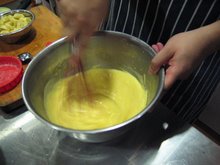

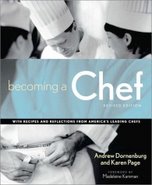
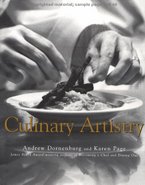


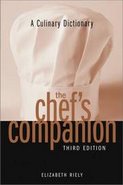


.jpg)
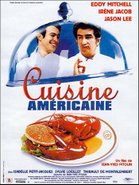




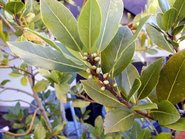
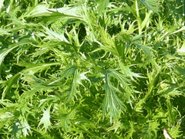
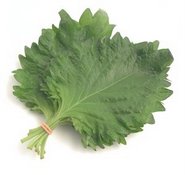


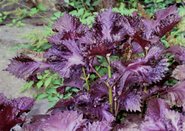
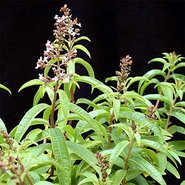
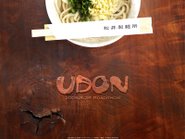





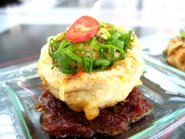


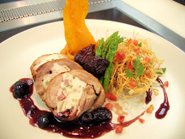
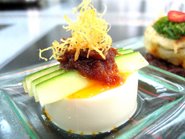
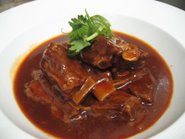
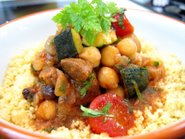
























































No comments:
Post a Comment